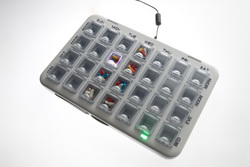 Pharmacy OneSource hosted a webinar “debate” today that had two excellent speakers presenting their cases for which technology should implement first; Computerized Physician Order Entry (CPOE) or Bar Code Medication Administration (BCMA). The webinar was well worth the time.
Pharmacy OneSource hosted a webinar “debate” today that had two excellent speakers presenting their cases for which technology should implement first; Computerized Physician Order Entry (CPOE) or Bar Code Medication Administration (BCMA). The webinar was well worth the time.
The case for CPOE was presented by John Poikonen, Pharm.D. John is the Clinical Informatics Director at UMass Memorial Health Care, an Academic Medical Center and health system in central Massachusetts. John is an interesting informaticist as he has repeatedly spoken out against the lack of evidence supporting BCMA. It was a good fit for him to argue for CPOE implementation ahead of BCMA. He brought up some great points and presented a fair amount of literature to back them up. You can read more of John’s musings at RxInformatics.com.
The case for BCMA was presented by Steve Rough, the Director of Pharmacy at the University of Wisconsin Hospital and Clinics, and Clinical Assistant Professor at the UW-Madison School of Pharmacy. Steve has done quite a bit of work with bar code medication scanning technology and presented an excellent case for BCMA.
Both presenters had valid reasons and good arguments for their positions. I for one am in favor of both CPOE and BCMA, but would personally push for BCMA ahead of CPOE for several reasons. CPOE requires a much larger investment in resources, both human and financial, when compared to BCMA. There is also a reasonable expectation that BCMA will stop errors at their most vulnerable point, the administration phase. I’ve mentioned this before and Steve brought up some of the very same points in his presentation. Finally, CPOE requires buy-in from physicians in order to be completely successful. And if there is one thing you can count on it’s that physicians will fight you tooth and nail when it comes to technology and change.
You can grab a copy of the presentation slides here.



